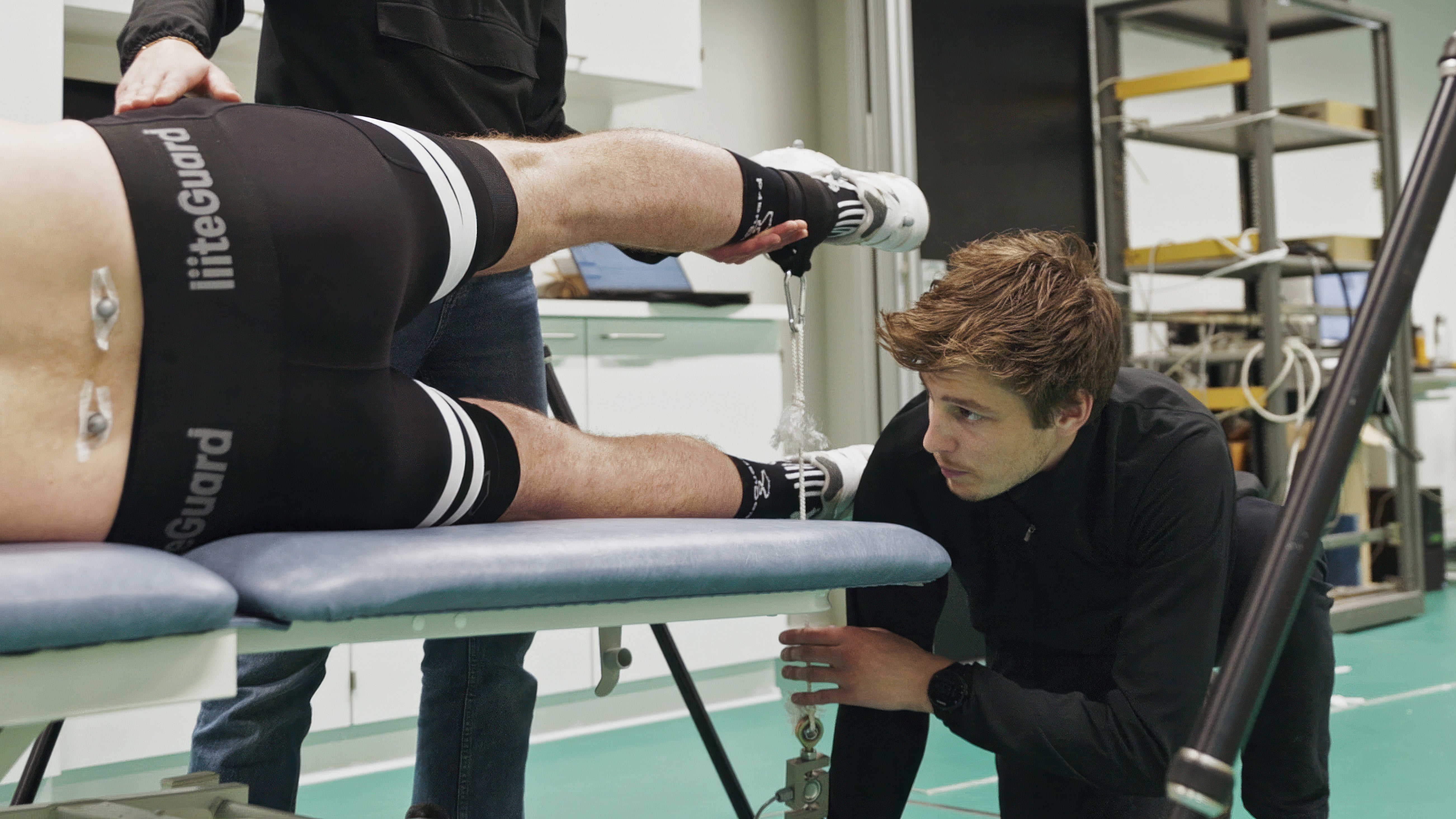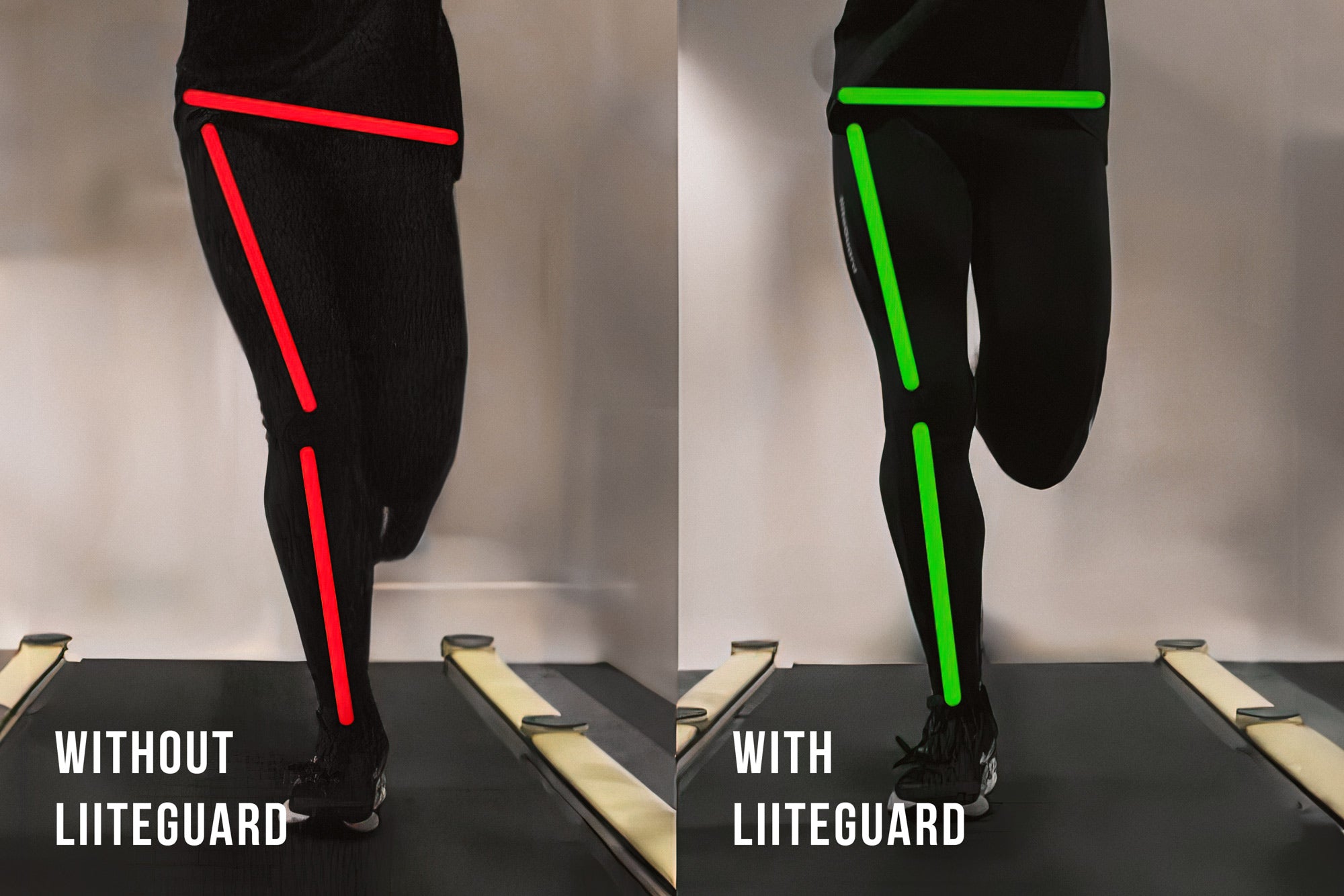Article: Scientific study indicates GLU-TECH running tights provide increased hip stability

Scientific study indicates GLU-TECH running tights provide increased hip stability
In the spring of 2023 liiteGuard had a scientific study done by two sports engineers who have studied at Aalborg University.
The study had the purpose of evaluating the effect of liiteGuard's GLU-TECH running tights on different hip movements after the gluteal muscles have been fatigued.
The results support an increase in stability around the hip.
The study has been conducted by Cand.scient.tech Christina Søby and Cand.scient.tech Frederik Mellemkjær.
Summary

- Two sports engineers, who have studied at Aalborg University, have researched the effect of liiteGuard's GLU-TECH running tights on different hip movements after the gluteal muscles have been fatigued.
- 648 steps were analysed at three different speeds on recreational runners with fatigued gluteal muscles.
- The results indicate, that the changes in movements around the hip caused by fatigue, are reduced by using liiteGuard GLU-TECH tights during running.
- Thus it seems, that GLU-TECH running tights can help provide increased stability around the hip when running.
Study: GLU-TECH running tights can reduce unfavorable changes in movements around the hip

On a normal run, the gluteal muscle Gluteus Medius (Gmed), plays a definitive role in making sure our leg, which is in contact with the surface, is in control [1].
As such, a weakness in GMed can reduce the dynamic stability around the hip caused by an increase in movement patterns [2].
This is especially the case when looking at movements, where the hip is more prone to lead the thigh laterally inwards (hip adduction), rotate the thigh inwards compared to the pelvis (inwards hip rotation), as well as an increase in lateral pelvis drop (see figure 1).

Figure 1: Definition of the analysed movements. (a) Hip adduction-abduction, (b) Inwards and outwards hip rotation, (c) Lateral pelvis drop. Source: AnyBody Modeling System™
Exaggerated hip adduction, inwards rotation and/or pelvis drop affects the body's ability to maintain balance and stability during load bearing activities, such as running [2].
A lack of dynamic stability around the hip will affect the rest of the body during running due to compensating for the aforementioned movements. This will especially cause changes around hip and knees, where a higher demand will be placed on muscles and tendons, which can be strained too much or unfavorably. and possibly result in an overload injury [2].
If your load during a run exceeds the muscle's strength capacity and it is fatigued further, it will cause a risk of compensating and performing unfavorable movements as described above. Through this, the risk of developing an injury is increased.
Therefore it is important to ensure, that the body attains the optimal strength for the given demands.
If not, we must improve our muscular strength, so it is capable of running for the desired amount.
The effect of strength training requires multiple weeks of training, where you, as a runner, can be forced to reduce or put a hold on your running training for a period of time [3].
In 2020 liiteGuard developed their GLU-TECH running tights with an elastic band placed at the lower back. The purpose of these tights were to provide a support and assistance for GMed, and at the same time ensure stability around the hip during the standing phase during running.
The purpose and structure of the study
The study had the purpose of determining whether or not GLU-TECH running tights had an effect on hip stability, when GMed was strained over time, and thereby fatigued.
The changes in movements (hip adduction-abduction, inwards and outwards hip rotation and lateral pelvis drop) were measured by using 3D running analysis in a movement lab at Aalborg University.
In the study 24 young adults were tested (17 men and 7 women), who had to have been injury free for at least the last six months, as well as have a low to moderate level of physical activity (a weekly average distance of at most 10km).
All participants had a warm up run on a treadmill, followed by a baseline running test, which was used to see the effects of the fatigue protocol.
To achieve a fatigue of GMed, the participants performed strength exercises aimed at this musculature. To ensure a proper level of fatigue had been achieved, a strength test was performed and compared before and after the fatigue protocol.
The requirement was a minimum reduction of 33% of the maximal muscle strength, where an average strength reduction of 46% was achieved. Hereafter the participants were split into two groups; One group started with a running test while wearing GLU-TECH running tights followed by a repeat of the fatigue protocol and lastly another running test while wearing control tights.
The second group performed the same tests, but in reversed order. The methodical approach is also depicted in figure 2.

Figure 2: The flow diagram represents the recruitment and test process for participants. GTT is used to represent GLU-TECH running tights.
Results
In figure 3 the results are presented.
648 steps were analysed for each speed level.
As the data shows, the study has found significant results among the three movements by usage of GLU-TECH running tights during fatigue compared to the control tights.
- Hip adduction was significantly reduces by 5.4%
- Inwards hip rotation was significantly reduced by 46%
- Lateral pelvis drop was significantly reduced by 12%

Figure 3. The angle reduction between GLU-TECH running tights and control tights. HAD: hip adduction. HIR: inwards hip rotation and LPD: lateral pelvis drop. * indicates a significant angle reduction.
GLU-TECH RUNNING TIGHTS CAN PROVIDE AN INCREASE IN HIP STABILITY
As such our results indicate, that the changes of movement around the hip while using GLU-TECH running tights, can have a positive effect on the hip stability, when GMed is fatigued.
This will be especially advantageous for runners, as you start to be tired out during a run, as it indicates that you, by using GLU-TECH running tights can achieve an increase in hipo stability.
An increase in stability around the hip when fatigued can reduce the risk of unfavorable loads on muscles, tendons and joints and thereby the risk of developing an overload injury [2].
It is important to point out, that the use of GLU-TECH running tights can not stand by itself, but relevant strength training, as well as frequency and gradual progression in your running training will be very important in ensuring a run with minimal risk of an overload injury.
References
[1] G. S. Nunes, T. Pizzari, R. Neate, C. J. Barton, and A. Semciw, “Gluteal muscle activity during running in asymptomatic people,” Gait and posture, vol. 80, pp. 268–273, 2020.
[2] C. M. Powers, “The influence of abnormal hip mechanics on knee injury: A biomechanical perspective,” The journal of orthopaedic and sports physical therapy, vol. 40, no. 2, pp. 42–51, 2010.
[3] L. Presswood, J. Cronin, J. W. L. Keogh, and C. Whatman, “Gluteus medius: Applied anatomy, dysfunction, assessment, and progressive strengthening,” Strength and conditioning journal, vol. 30, no. 5, pp. 41–53, 2008.
You can read the study in full length by clicking here.
If you have any questions or want to know more about the study, we welcome you to contact us at info@liiteguard.com.




Leave a comment
This site is protected by hCaptcha and the hCaptcha Privacy Policy and Terms of Service apply.